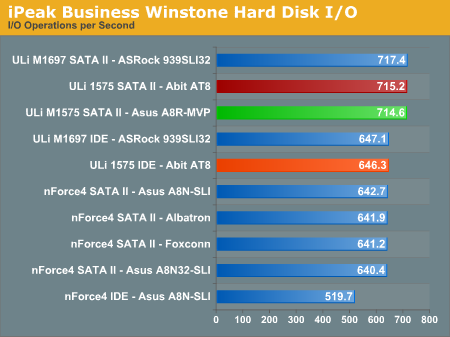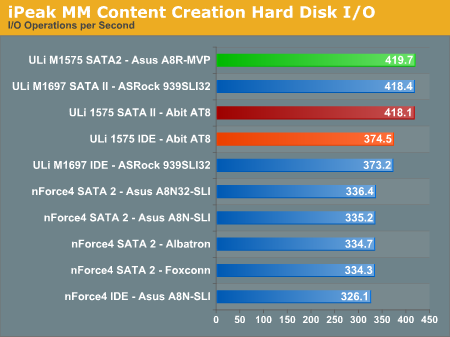Abit AT8: µGuru comes to the RD480
by Gary Key on March 10, 2006 12:05 AM EST- Posted in
- Motherboards
Disk Controller Performance
With the variety of disk drive benchmarks available, we needed a means of comparing the true performance of the wide selection of controllers. The logical choice was Anand's storage benchmark first described in Q2 2004 Desktop Hard Drive Comparison: WD Raptor vs. the World. The iPeak test was designed to measure "pure" hard disk performance, and in this case, we kept the hard drive as consistent as possible while varying the hard drive controller. The idea is to measure the performance of a hard drive controller with a consistent hard drive.
We played back Anand's raw files that recorded I/O operations when running a real world benchmark - the entire Winstone 2004 suite. Intel's iPEAK utility was then used to play back the trace file of all IO operations that took place during a single run of Business Winstone 2004 and MCC Winstone 2004. To try to isolate performance differences to the controllers that we were testing, we used the Maxtor MaXLine III 7L300S0 300GB 7200 RPM SATA drive in all tests . The drive was formatted before each test run and a composite average of 5 tests on each controller interface was tabulated in order to ensure consistency in the benchmark.
iPeak gives a mean service time in milliseconds; in other words, the average time that each drive took to fulfill each IO operation. In order to make the data more understandable, we report the scores as an average number of IO operations per second so that higher scores translate into better performance. This number is meaningless as far as hard disk performance is concerned, as it is just the number of IO operations completed in a second. However, the scores are useful for comparing "pure" performance of the storage controllers in this case.
With the variety of disk drive benchmarks available, we needed a means of comparing the true performance of the wide selection of controllers. The logical choice was Anand's storage benchmark first described in Q2 2004 Desktop Hard Drive Comparison: WD Raptor vs. the World. The iPeak test was designed to measure "pure" hard disk performance, and in this case, we kept the hard drive as consistent as possible while varying the hard drive controller. The idea is to measure the performance of a hard drive controller with a consistent hard drive.
We played back Anand's raw files that recorded I/O operations when running a real world benchmark - the entire Winstone 2004 suite. Intel's iPEAK utility was then used to play back the trace file of all IO operations that took place during a single run of Business Winstone 2004 and MCC Winstone 2004. To try to isolate performance differences to the controllers that we were testing, we used the Maxtor MaXLine III 7L300S0 300GB 7200 RPM SATA drive in all tests . The drive was formatted before each test run and a composite average of 5 tests on each controller interface was tabulated in order to ensure consistency in the benchmark.
iPeak gives a mean service time in milliseconds; in other words, the average time that each drive took to fulfill each IO operation. In order to make the data more understandable, we report the scores as an average number of IO operations per second so that higher scores translate into better performance. This number is meaningless as far as hard disk performance is concerned, as it is just the number of IO operations completed in a second. However, the scores are useful for comparing "pure" performance of the storage controllers in this case.












42 Comments
View All Comments
FireTech - Monday, April 10, 2006 - link
Status Update - Revised 1.1 BiosAbit provided us a revised 1.1 bios tonight (3-9-06) for additional testing and it will be available on Abit's website shortly. We will update the article after our regression testing is completed.
Hi Gary, it would be great if you could please do that promised follow-up review update for the AT8 especially now the AT8 32X is out. It has beeen a while since the initial review and so things should have settled down now or possibly even a new 'beyond 1.1' beta BIOS has been produced for you?
Please update this review and maybe have a follow up on all the Crossfire boards you have reviewed. There seem to be quite a few owners talking on various forums who bought on the strength of these reviews and are relying on you to get things moving on the manufacturer support front...
I'm personally just waiting to see if the AT8 can be the board it was advertised to be before I take the plunge. Why buy into trouble if you don't need to, I've done the 'early adopter' thing too often already?
Gary Key - Monday, July 3, 2006 - link
We are still seeing issues with Infineon based memory that is set to 2-3-2-5 in the SPD, the board will not boot. If your memory utilizes these IC chips, the only choice you is to install some Samsung TCCD, boot the board, manually change the CAS to 2.5, reboot, shutdown, install the other memory, and boot again. Hopefully, Abit will do another bios spin, otherwise, you are left with this hack.Zoomer - Tuesday, March 21, 2006 - link
Wish you could plug abit's use of the 882D more, it seems to be an excellent realtek chipset. It matches the x-fi in the 3d rightmark tests and is competitive with it even in games. Excellent job!Another thing: Could you guys do some objective listening tests to the audio output? Blind A/B switches between the HDA and onboard audio using good quality speakers and/or headphones will be welcome. :)
Gary Key - Friday, March 24, 2006 - link
Our next step in audio testing, besides subjective remarks, will be doing objective audio tests (besides sampling output from RMAA 5.5) on each new codec implemented on a board. We are still deciding how to do this and my personal preference is to provide a download link to a high quality audio output file from each codec tested. These files would be a standardized clip from a music selection, movie scene, and game sequence. The question is if we will receive permission from the involved parties to allow distribution and obviously what choice of equipment to utilize for the audio capture without distorting the file before playback through the on-board codec or discreet card. Something on the list to do besides new creating new benchmarks also....... :)
Zoomer - Saturday, March 25, 2006 - link
Oh sorry, I meant to say subjective blind listening tests. But that might be a good idea too. To avoid licensing issues, you could use public domain music. However, the quality of the client output hardware and the recording method used would taint results.Duplex - Friday, March 24, 2006 - link
A suggestion to develop the audiotest is that you measure 1. the latency from input(ad) to "software" and 2. from input(ad) to "software" to output(da) with or without some well defined effect applied.Realtek: We don't support ASIO & GSIF directly in our driver.
For ASIO, there is an "universal ASIO driver for WDM audio" available on ASIO4ALL. Please refer to http://www.asio4all.com">http://www.asio4all.com. It is free for end-users.
Zoomer - Tuesday, March 21, 2006 - link
If I am reading it correctly, you are saying the primary slot is the 4th from the cpu, or in the middle of the board and will cover 1 pci slot when used.If that is correct, I suspect this will be a deal breaker for many. It effectively transforms the board to having 1 PCI slot or even none at all, and 2 usable but useless pcie slots, 1 1x and another 8x.
Gary Key - Friday, March 24, 2006 - link
Yes, the primary x16 slot is the lower x16 slot on the board. If you use a X1900XT (dual slot card) as an example you will render the PCI slot next to it useless.
Zoomer - Saturday, March 25, 2006 - link
Well, I think it was a bad decision on abit's part. Why leave the top part of the board free while overcrowding the bottom? End users are suffering from these strange board design because of nvidia's SLI now.PS: Yes, I do think SLI is a terribly bad idea.
Operandi - Sunday, March 12, 2006 - link
Excellent review I particularly liked the coverage on the fan control, good work.